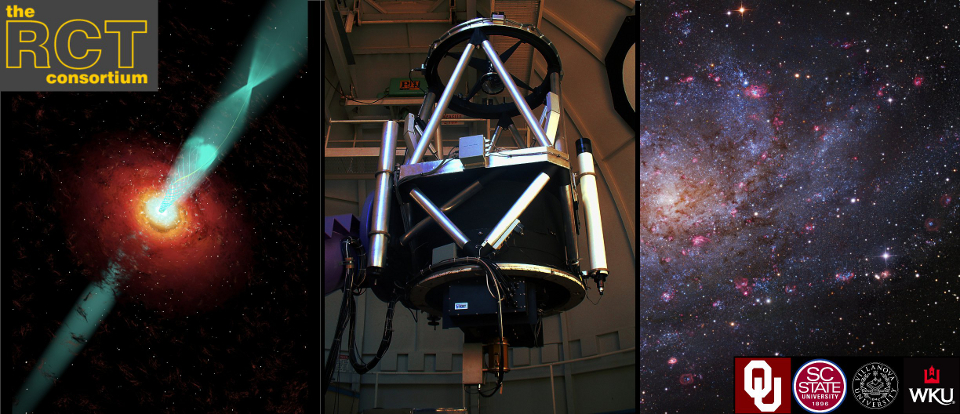The Robotically-Controlled Telescope (RCT) is a 1.3-meter (50inch) f/14 Cassegrain telescope on a German equatorial mount. Located on Kitt Peak in southern Arizona at an elevation of 2070 meters (6790 feet), the RCT occupies the dome across from the Kitt Peak Visitors’ Center and adjacent to the KPNO administration building. The RCT name originally stood for Remotely-Controlled Telescope, and it served the KPNO user community almost 30 years before being closed in 1995 (read more on the RCT history page).

The RCT site highlighted on an image of Kitt Peak National Observatory. The long building attached to the RCT dome is the Kitt Peak administration building. Image Copyright Association of Universities for Research in Astronomy Inc. (AURA), all rights reserved. Inset modification by G. A. Esquerdo.
The RCT Consortium operates the telescope with a CCD camera employing a 4302×4098 pixel ON Semi CCD (15 micron pixels for a plate scale of 0.168 arcsec/pixel and 12.18×11.61 arcmin field of view). This camera is thermoelectrically cooled to -100 C, which is enough to keep noise levels very low. Two filter wheels are available at all times on the telescope and hold up to 16 broadband and narrowband filters.
The telescope can be operated in different observing modes. In automatic mode, the telescope opens automatically and executes a series of observations, deciding which objects to observe based on a list of pre-established scheduling priorities and observing conditions. A weather station next to the dome monitors the conditions to ensure the telescope’s safety. The RCT can also be controlled remotely via the internet, executing tasks in real time for an observer located anywhere in the world. Finally, an on-site observer can control the telescope’s functions from a warm room located inside the dome.
Besides a computer network for camera and observatory control, computers in the dome archive the data automatically after each night’s observations.
The RCT filter set currently contains the UBVRI broadband filter set, a red continuum filter (6444Å) and narrowband filters for H alpha (6563Å) and CN (3870Å) in filter wheel 1. Filter wheel 2 contains filters for NH2 (5721Å) and continuum (5660Å), C2 (5141Å) and green continuum (5260Å), C3 (4062Å) and a diffuser, together with narrowband filters for SII (6717Å) and OIII (5007Å). The CN, NH2, C2 and C3 filters are intended for observations of comets. A third filter wheel currently holds filters for He II (4689Å), H beta, , NII (5759Å & 6585Å), and SII (6731Å) . Other filters available include OH (3090Å) and blue and UV continuum.
